- Quick Read
- Deep Read ( 4 Min. )

Why is Christian Science in our name?
Our name is about honesty. The Monitor is owned by The Christian Science Church, and we’ve always been transparent about that.
The Church publishes the Monitor because it sees good journalism as vital to progress in the world. Since 1908, we’ve aimed “to injure no man, but to bless all mankind,” as our founder, Mary Baker Eddy, put it.
Here, you’ll find award-winning journalism not driven by commercial influences – a news organization that takes seriously its mission to uplift the world by seeking solutions and finding reasons for credible hope.
Explore values journalism About usIn Today’s Issue
- What unpopular president’s death means for continuity vs. change in Iran
- Today’s news briefs
- Can Ukraine attack inside Russia? Kyiv wants US to say yes.
- Taiwan’s new president urges China to ‘face reality’ and work toward peace
- How doulas and cafes help people break the last taboo – talking about death
- A potato masher, didgeridoo, and, uh, six vacuums. Why I rescue trash.
Monitor Daily Podcast
- Follow us:
- Apple Podcasts
- Spotify
- RSS Feed
- Download
TODAY’S INTRO
A responsive take, but not a ‘hot’ one
Every news story is also a media story.
When Iranian state media said on Sunday that a helicopter in the convoy of Ebrahim Raisi, the president, had experienced a “hard landing,” the combination of an insular government’s opacity and internet rumor-mongering only added to the fog.
At the Monitor, we always talk about how we can add something distinctive – often, calm context – before we commit real resources to a breaking story. (Our managing editor spoke about this on our podcast last year.)
Our piece today leverages the light-bringing expertise of Scott Peterson, a writer who has traveled inside the Islamic Republic 30 times and written a book about it. Scott brings perspective – at the speed of news.
Share this article
Link copied.

Help fund Monitor journalism for $11/ month
Already a subscriber? Login

Monitor journalism changes lives because we open that too-small box that most people think they live in. We believe news can and should expand a sense of identity and possibility beyond narrow conventional expectations.
Our work isn't possible without your support.
What unpopular president’s death means for continuity vs. change in Iran
In the Iranian leadership’s conduct of internal elections and foreign relations, the primary focus has been the continuity of the Islamic Republic. President Ebrahim Raisi, who was killed in a helicopter crash, embodied that continuity.
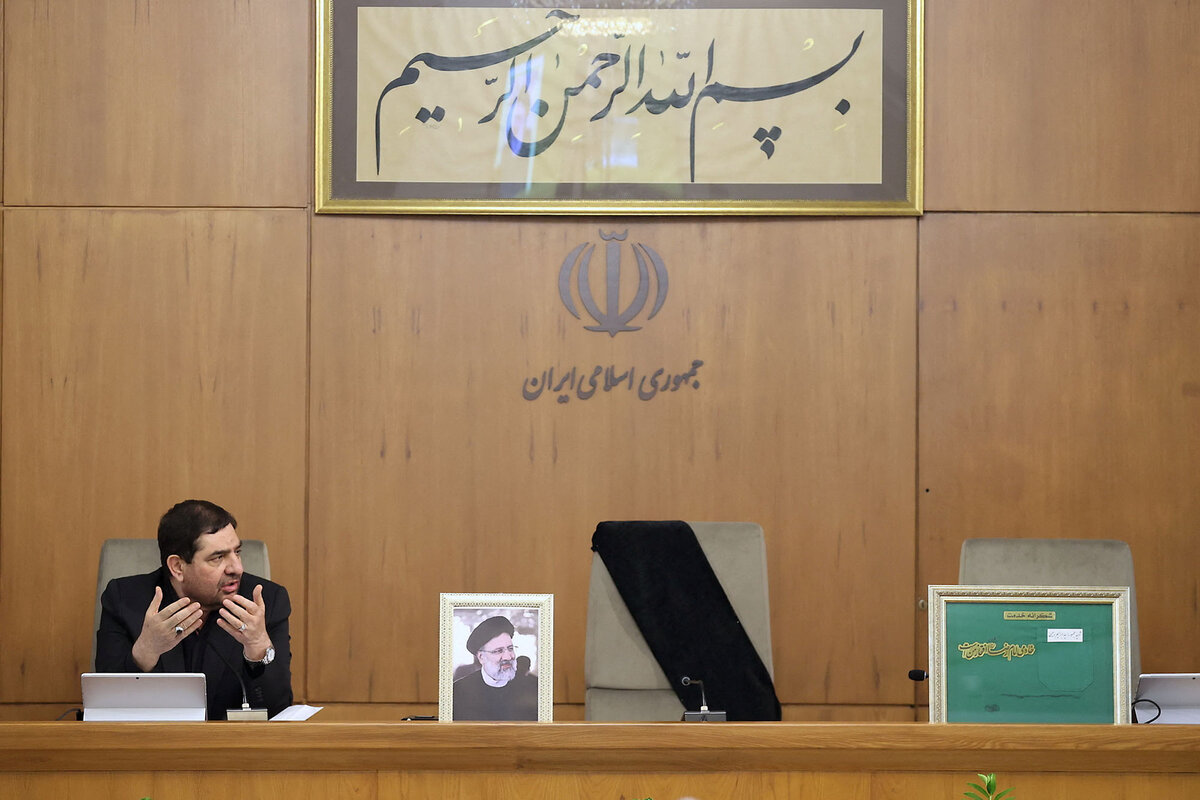
The loss in a helicopter crash of Iranian President Ebrahim Raisi, associated with some of the Islamic Republic’s most repressive episodes, comes at a fraught moment for the nation’s leadership, which is under pressure both at home and abroad.
Iran’s supreme leader, Ayatolloh Ali Khamenei, vowed there would be continuity, and analysts indeed expect few changes to strategy or policy.
Yet with Mr. Raisi’s name struck from atop the list of possible candidates to succeed the 85-year-old supreme leader, elite jockeying may ensue that could shape the future trajectory of Iran.
Mr. Raisi “will be remembered as an unpopular president who turned the role of the chief executive of the Islamic Republic into that of a yes man,” says Ali Vaez, director of the Iran project at the International Crisis Group.
While analysts note that conservative rule in Iran has been carefully solidified in recent years, the cost has been high in terms of regime popularity.
The death of Mr. Raisi may present an opportunity to “reverse course, to get voters back into the political process,” says Mohammad Ali Shabani. But that would also require a strategic decision, and for Mr. Khamenei to fight off the very hard-line forces that he initially allowed to stamp out reform politics altogether.
What unpopular president’s death means for continuity vs. change in Iran
Even as Iranian President Ebrahim Raisi’s helicopter remained missing and his condition unknown late Sunday, Iran’s supreme leader, Ayatollah Ali Khamenei, sought to calm the nation.
Pray for your president, he said. But if he does not come back, “rest assured that there will be no disruption in the country’s affairs.”
Mr. Raisi was confirmed dead Monday when the remains of the helicopter were found on a steep hillside in northwest Iran locked in by fog and bad weather. Also killed in the crash, which state media attributed to mechanical failure, were Foreign Minister Hossein Amir-Abdollahian and other senior officials returning from a trip to Azerbaijan.
First Vice President Mohammad Mokhber will assume the role of president, Mr. Khamenei said Monday, until elections can be held to replace Mr. Raisi.
The loss of Iran’s hard-line president comes at a fraught moment for the Islamic Republic, which is under pressure both at home and abroad like never before in recent decades. Analysts, however, expect few changes to strategy or policy – just as Mr. Khamenei promised.
Yet with Mr. Raisi’s name struck from atop the list of possible candidates to succeed the 85-year-old supreme leader, elite jockeying may ensue that could shape the future trajectory of Iran.
“The reality is that no Iranian president in recent history has gone as far as President Raisi in disempowering the executive branch,” says Ali Vaez, director of the Iran project at the International Crisis Group. “He will be remembered as an unpopular president who turned the role of the chief executive of the Islamic Republic into that of a yes man.”
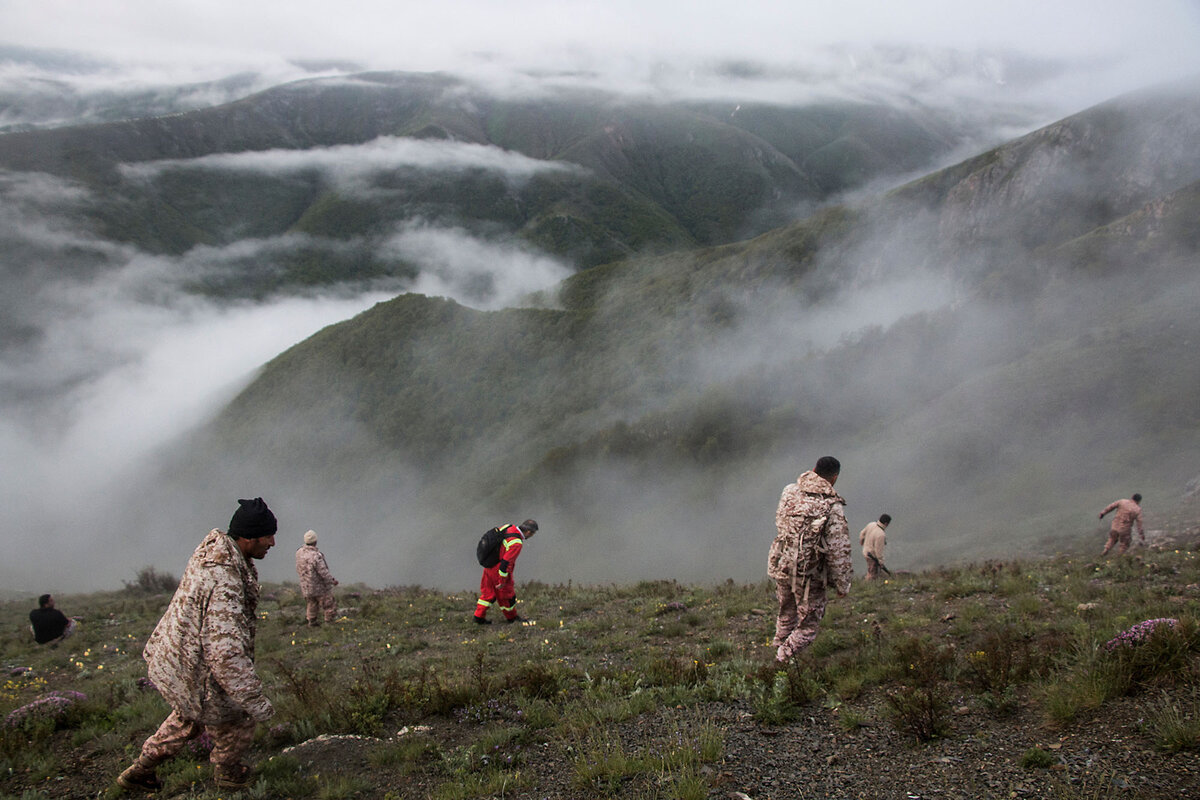
Mr. Raisi won the most votes in a choreographed 2021 contest in which all reform-minded and other consequential conservative candidates were ruled ineligible. The election saw the lowest voter turnout by far of any Iranian presidential race since the 1979 Islamic Revolution – less than 50%.
“I expect more continuity than change, especially when it comes to foreign policy,” says Mr. Vaez, noting that the supreme leader and Revolutionary Guard set Iran’s regional and nuclear policies, and President Raisi and his foreign minister were “mere spokespersons for those policies.”
Another reason not to expect change is because, while the Islamic Republic is “at the nadir of its legitimacy at home,” he says, it is also “at the zenith of its exclusionary policies – which means it is most likely going to disqualify any candidates who are even considered loyal critics of the system, and would only allow candidates who are as subservient as President Raisi to assume office.”
Mr. Raisi was associated with some of the Islamic Republic’s most repressive episodes. He played a key role as a judge on a four-person panel that came to be known as the “death committee,” which in 1988 led to the swift executions of some 5,000 prisoners. Mr. Raisi also presided over the brutal crackdown on nationwide protests that were triggered in 2022 by the killing of a young Kurdish woman by what’s known as the morality police for allegedly not fully covering her hair. Rights groups estimate that more than 500 died.
The Tehran Times announced the news of the president’s death with a banner headline, “Martyrdom in the line of duty,” and official media trumpeted Mr. Raisi’s achievements. But there was also some celebration – even fireworks in some Kurdish areas of western Iran – and countless jokes and memes mocking the late president on social media.
Indeed, inside Iran an increasing portion of the population has been systematically disenfranchised by an elite hard-line minority, which controls every lever of power and has violently demonstrated that it brooks no dissent.
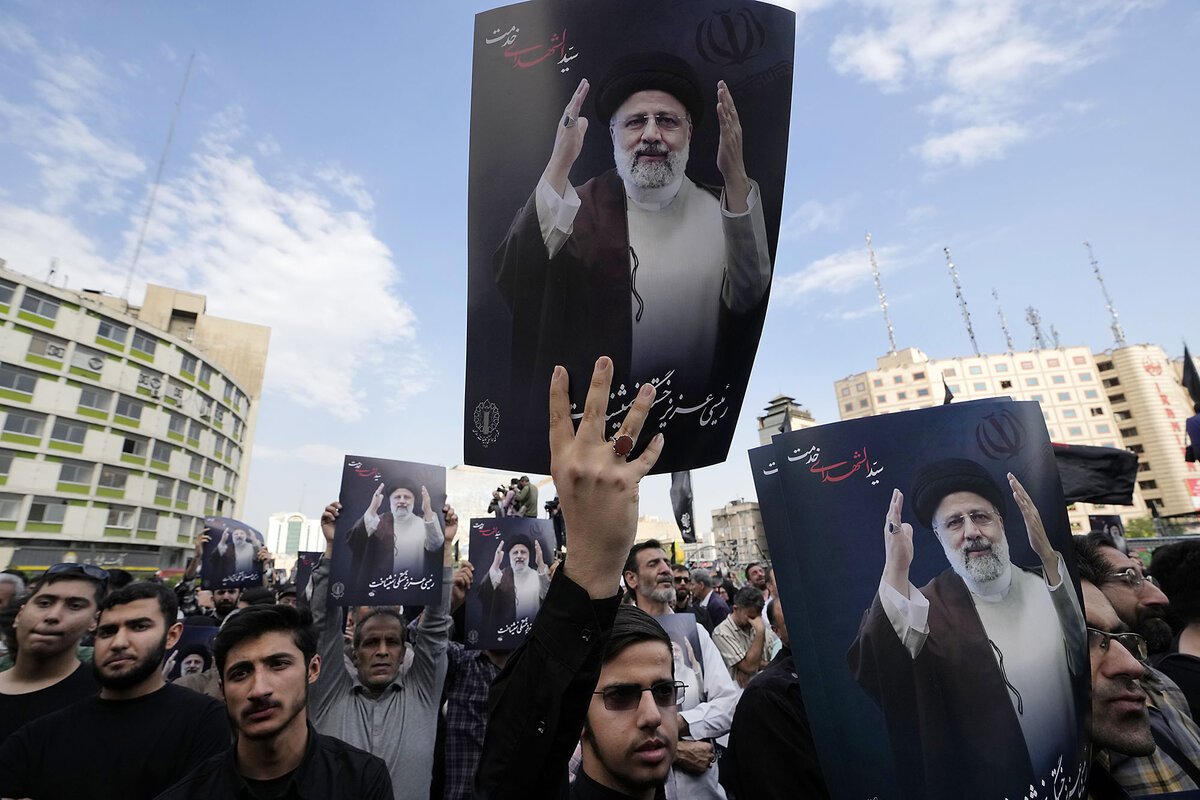
Outside Iran, the country’s indirect shadow war against Israel and American interests in the Middle East – a war waged via Iran-backed “Axis of Resistance” regional forces – turned into a risky direct confrontation last month. Iran launched more than 300 missiles and drones at Israel from its own soil April 13 in retaliation for an Israeli strike against Iranian generals in Syria.
While analysts note that conservative rule in Iran has been carefully solidified in recent years, the cost has been high in terms of regime popularity.
Meanwhile, the upcoming emergency presidential vote, which must be held within 50 days, could ultimately have a bearing on who will succeed Mr. Khamenei.
“The impact of Raisi’s death on leadership succession will be most acutely felt in how Khamenei approaches the early elections,” says Mohammad Ali Shabani, editor of Amwaj.media, a London-based news site focusing on Iran, Iraq, and the Arabian Peninsula countries.
For decades, Mr. Khamenei cast Iran’s high election turnouts as evidence of the Islamic Revolution’s popular mandate, and often mocked foreign elections’ low turnout as proof of indifference, says Mr. Shabani. In Iran, voter turnout has dropped since 2000, including a record low of 8% in Tehran on May 10, in a parliamentary runoff vote.
The death of Mr. Raisi may present an opportunity to “reverse course, to get voters back into the political process,” says Mr. Shabani. But that would also require a strategic decision, and for Mr. Khamenei to fight off the very hard-line forces that he initially allowed to stamp out reform politics altogether.
“A pro-reform resurgence in the polls will help shift dynamics on leadership succession,” says Mr. Shabani. “Conversely, their total sidelining from power once again will indicate the future [hard-line] direction of Iran under the Islamic Republic.”

Today’s news briefs
• ICC seeks arrest warrants: The chief prosecutor of the International Criminal Court says he believes Israeli Prime Minister Benjamin Netanyahu, Israel’s defense minister, and three Hamas leaders are responsible for war crimes and crimes against humanity in Gaza and Israel.
• Trump trial latest: Witness Michael Cohen finishes testifying, and the prosecution in Donald Trump’s trial rests its case. Mr. Cohen admits to jurors in the Republican’s hush money trial that he stole tens of thousands of dollars from Mr. Trump’s company.
• India keeps voting: Millions of Indians across 49 constituencies cast ballots as the country’s six-week-long election enters its final stages – including in northern Ayodhya city, where Prime Minister Narendra Modi opened a controversial Hindu temple on the site of a razed mosque.
• New bid to block statehood: Israel calls for the United States to help stop the establishment of a Palestinian state. European Union members including Ireland, Spain, Slovenia, and Malta have said they could recognize a Palestinian state this month.
• In Japan, pay to hike: Hikers wanting to climb one of the most popular trails of the iconic Mount Fuji will now have to reserve ahead and pay a fee as the picturesque volcano struggles with overtourism, littering, and those who attempt rushed “bullet climbing,” putting lives at risk.

Can Ukraine attack inside Russia? Kyiv wants US to say yes.
U.S. military aid is reaching Ukraine with much-needed ammunition. But Kyiv wants to use Western weapons to hit inside Russia. Is that a necessary strategy or a dangerous escalation?

- Quick Read
- Deep Read ( 5 Min. )
As Russian forces bear down on the region that is home to Kharkiv, Ukraine’s second-largest city, Defense Department officials say they are rushing U.S. arms into the country as quickly as they can.
The United States has provided Kyiv with artillery shells and missiles, including a 200-mile-range variant of the Army Tactical Missile System, known as ATACMS, which Ukraine began using last month. These are now allowing Kyiv to hit Russian bases – and supply hubs – behind the front lines in Ukrainian territory.
U.S. officials provided ATACMS only after extracting promises from Kyiv that it wouldn’t use them to strike inside Russia.
Now the new big ask among Ukrainian officials is permission from Washington to rescind these promises. Allowing broader use of Western weapons could swing momentum in Kyiv’s direction, supporters say, and signal unequivocally that it is America’s strategic objective that Ukraine beats Russia and wins this war.
“There’s a clear tension between helping Ukraine do absolutely everything that it might want to do to win the war, and the risks of escalation,” says Emma Ashford, a senior fellow in the Reimagining US Grand Strategy program at the Stimson Center, a nonpartisan think tank focusing on global peace.
Can Ukraine attack inside Russia? Kyiv wants US to say yes.
As Russian forces bear down on the region that is home to Kharkiv, Ukraine’s second-largest city, Defense Department officials say they are rushing U.S. arms into the country as quickly as they can.
It has helped that in the months it awaited congressional approval to send $60 billion in military equipment and weapons for Kyiv, the Pentagon prepositioned what it could to deliver as soon as lawmakers gave the green light, which happened late last month.
Still, the delay was detrimental, as Kyiv’s front-line troops, among other travails, were forced to ration ammunition. “They did suffer from that,” Deputy Pentagon Press Secretary Sabrina Singh said last week, “and we did see them lose some territory to the Russians.”
The latest aid includes artillery shells – which will be a welcome arrival, since Ukrainian officials estimate that Russia outnumbers them about 10-to-1 in these supplies – as well as much-needed missiles for air defense systems.
The United States has also quietly provided Kyiv with a 200-mile-range variant of the Army Tactical Missile System, known as ATACMS, which Ukraine began using last month. These are now allowing Kyiv to hit Russian bases – and supply hubs – behind the front lines in Ukrainian territory.
This comes on the heels of more than a year of debate about whether such missiles would lead to a dangerous escalation of the war, particularly if Ukraine used them to strike inside Russia. U.S. officials provided the weapons only after extracting promises from Kyiv that this wouldn’t happen.
Now the new big ask among Ukrainian officials – including some who visited Capitol Hill recently – is permission from Washington and other Western allies to rescind these promises. Allowing broader use of Western weapons could swing momentum in Kyiv’s direction, supporters say, and signal unequivocally that it is America’s strategic objective that Ukraine beats Russia and wins this war.
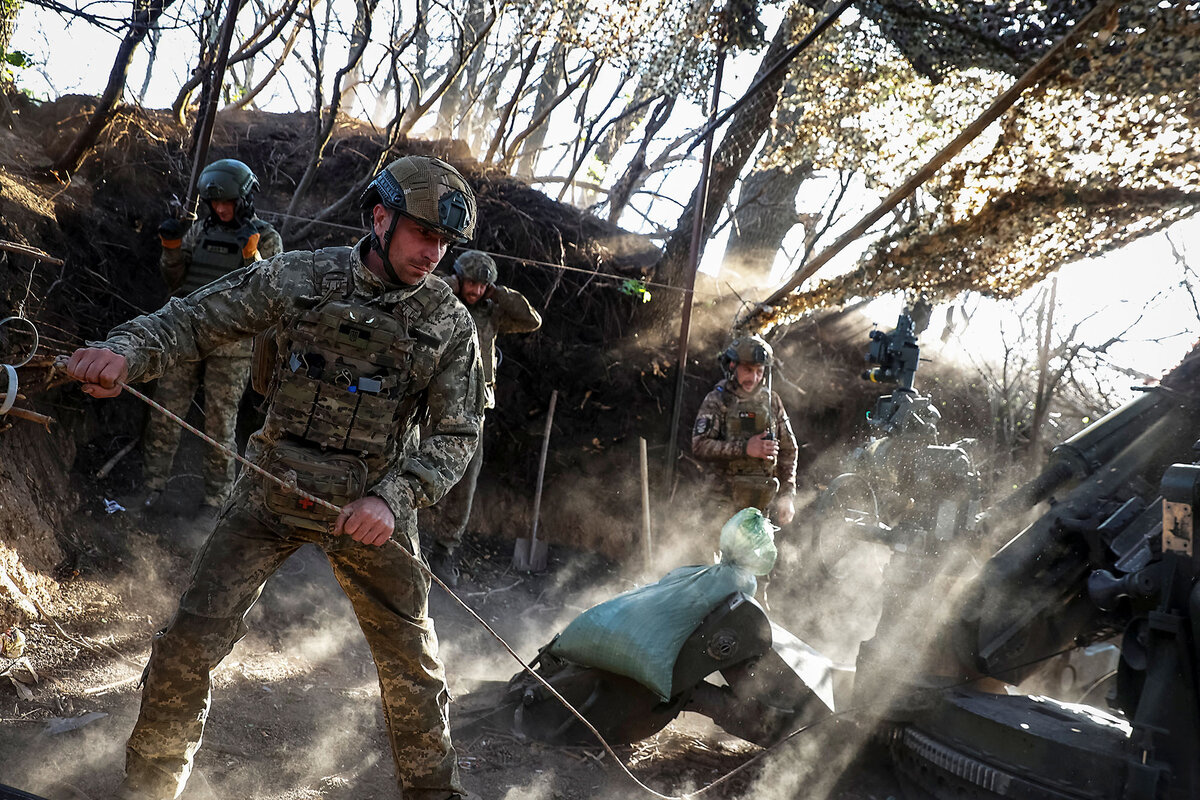
Ukrainian President Volodymyr Zelenskyy said last week that Moscow’s “biggest advantage” in the war is Kyiv’s ban on using Western-provided weapons to hit Russia proper.
Western officials are slowly starting to relent, as they did with supplying long-range missiles. “Just as Russia is striking inside Ukraine, you can quite understand why Ukraine feels the need to make sure it’s defending itself,” British Foreign Secretary David Cameron said during a visit to Kyiv earlier this month, adding that Ukraine had “the right” to use its weapons to strike back.
It was a notable change of policy – so notable, in fact, that it prompted some nuclear saber rattling from Moscow, which on May 6 announced military drills involving tactical nuclear weapons on the border with Ukraine.
Yet unsettling though veiled Kremlin threats may be, some defense analysts argue – without being cavalier about nuclear risk, they are quick to add – that in potentially allowing themselves to be governed by their greatest fears about Russian retaliation, Western leaders risk succumbing to intimidation.
“Our problem all along is that we have been deterring ourselves over the possibility that Russia might use a nuclear weapon,” says retired Lt. Gen. Frederick “Ben” Hodges, former commander of U.S. Army forces in Europe. “And the Russians see that we are deterred.”
A fine line between assisting and risking escalation
For now, Russia is able to take advantage of Western arms restrictions to create sanctuaries just outside Ukraine’s borders to shield its ammunition, fuel depots, radars, motor pools, and more from Ukrainian strikes, the Institute for the Study of War warned last week.
Most recently, Russia has been using these spaces to assemble significant force on its side of the border, the institute reports. Some of these forces recently moved into Ukraine’s northeastern Kharkiv region, where Russian President Vladimir Putin says he plans to create a buffer against Ukrainian shelling.
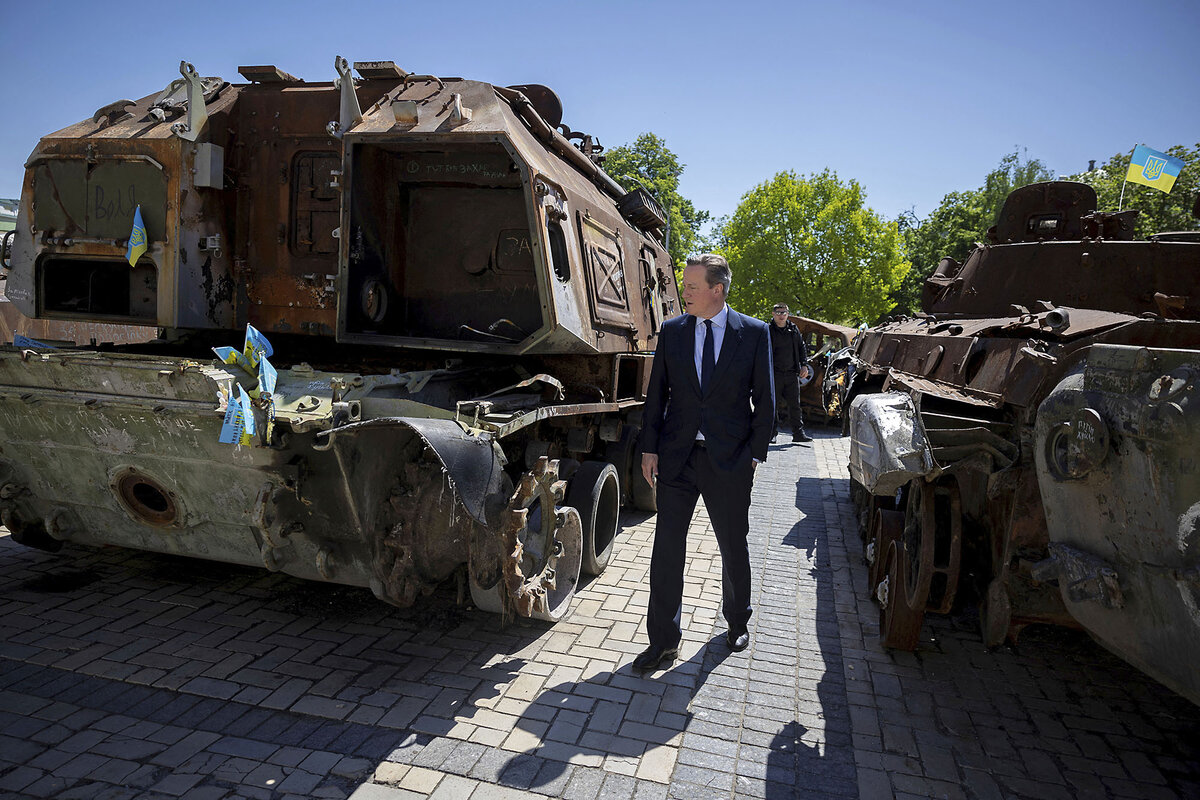
While Mr. Putin says he does not intend, in this latest offensive, to take Kharkiv, it is certainly an effort to force Kyiv to spread its troops thin, analysts say.
As devastating as these developments are for Ukraine’s war effort, however, U.S. officials are mindful that moves like lifting U.S. weapons restrictions, which would be beneficial for Kyiv, are not necessarily good for Washington, notes Emma Ashford, a senior fellow in the Reimagining US Grand Strategy program at the Stimson Center, a nonpartisan think tank focusing on global peace.
“There’s a clear tension between helping Ukraine do absolutely everything that it might want to do to win the war, and the risks of escalation,” she says. “I think the Biden administration for the most part has been quite sensible on this.”
While “a small number of limited strikes inside Russia does not seem to be terribly escalatory, I think the fear is that it’s a slippery slope.”
What’s more, Russian retaliation doesn’t have to be nuclear to be troubling, Dr. Ashford adds, pointing to sabotage campaigns such as jamming GPS systems and even warehouse arson that the Kremlin is suspected of ramping up in Western Europe.
Aid packages offer “practical help”
There are the practical concerns as well. Biden administration officials have prevailed on Kyiv to halt its drone hits on oil refineries inside Russia, since they raise prices of global energy – and of domestic gas.

Officials in Kyiv have ignored these entreaties, arguing that they are necessary to extract some price from Russia for its attacks on Ukraine’s energy sector – which has been left vulnerable, they add, by a dearth of air defenses.
Allies are endeavoring to address these shortfalls with the latest aid packages, which include air defenses.
The aid will also be helpful in repelling a ferocious glide bombing campaign that Moscow has lately been waging in order to overwhelm and exhaust Ukraine’s dwindling air defenses.
The Center for European Policy Analysis (CEPA) has dubbed these simple bombs – which are essentially Soviet-era munitions with wings and a modern navigation system – Russia’s “wonder weapon,” noting that they are “near impossible” for Ukraine to intercept at the moment.
Fighter jets would be the best option to take on the glide bombers, CEPA says, but they have yet to be transferred to Kyiv as Ukrainian pilots continue to undergo flight training.
At a meeting of top NATO officers in Brussels last week, the chair of the alliance’s military committee, Dutch Adm. Rob Bauer, acknowledged delays in weapons deliveries, and that promises to provide equipment must also come with concrete plans to get them to Ukraine.
“I think that is something that needs to improve,” he said Friday, adding that a number of chiefs of defense at the NATO talks agreed. “I think we’ll see now that there is practical help on its way.”

Taiwan’s new president urges China to ‘face reality’ and work toward peace
The inauguration of Taiwan’s new president marks a fresh chapter in cross-strait relations. Can President Lai Ching-te – whose party lacks a legislative majority and faces an ongoing charm offensive from Beijing – maintain peace?

- Quick Read
- Deep Read ( 5 Min. )
Taiwan’s new president urged China on Monday to work with the self-governed island – as equals – to prevent a war that both sides agree would devastate the world.
During his inaugural address, Lai Ching-te called on China “to stop its political attacks and military threats against Taiwan,” drawing cheers from a crowd gathered outside the flag-festooned, baroque-style Presidential Office Building in downtown Taipei.
Striking a confident and pragmatic tone, Dr. Lai reaffirmed his determination to strengthen Taiwan’s vibrant democracy while maintaining the status quo across the Taiwan Strait – a delicate balancing act handled deftly by his predecessor.
While his election victory in January marked a historic third term for the ruling Democratic Progressive Party, it also lost its majority in parliament. And Beijing has condemned Dr. Lai – who once called himself “a practical worker for Taiwan independence” – as “despicable.”
Dr. Lai said Taiwan’s government is ready to boost cooperation with China, but he also warned that Taiwanese citizens “must not harbor any delusions” about Beijing’s long-standing aim of uniting Taiwan with the mainland – by force, if necessary.
“I hope that China will face the reality of the Republic of China’s existence, respect the choices of the people in Taiwan, and in good faith, choose dialogue over confrontation,” Dr. Lai said.
Taiwan’s new president urges China to ‘face reality’ and work toward peace

Taiwan’s new president urged China on Monday to “face reality,” end its military incursions across the Taiwan Strait, and work with the self-governed island – as equals – to prevent a war that both sides agree would devastate the world.
“China’s military actions and gray-zone coercion are considered the greatest strategic challenges to global peace and stability,” President Lai Ching-te said in his inaugural address to the nation and visiting dignitaries, soon after he and Vice President Hsiao Bi-khim, Taiwan’s former envoy to the United States, took their oaths of office.
“I … want to call on China to stop its political attacks and military threats against Taiwan,” Dr. Lai said, drawing cheers and applause from a large crowd gathered outside the flag-festooned, baroque-style Presidential Office Building in downtown Taipei.
Striking a tone both confident and pragmatic, Dr. Lai reaffirmed his determination to strengthen Taiwan’s vibrant democracy while maintaining the status quo across the Taiwan Strait – a delicate balancing act handled deftly by his predecessor, Tsai Ing-wen. Taiwan’s first female president, Ms. Tsai served two four-year terms, the maximum allowed by the constitution. Dr. Lai was Taiwan’s vice president under Ms. Tsai, and his election victory in January marked a historic third term for the ruling Democratic Progressive Party (DPP).
An enthusiastic crowd greeted Dr. Lai’s speech. “I can feel his firm attitude – I like it,” says Wang Shuyun, a Taipei doctor.
“He gives me a lot of confidence. He’s pragmatic and he can lead Taiwan into a new situation,” says Weng Weichien, a civil servant, moments after a fly-over by Air Force jets issuing streams of multicolored smoke.
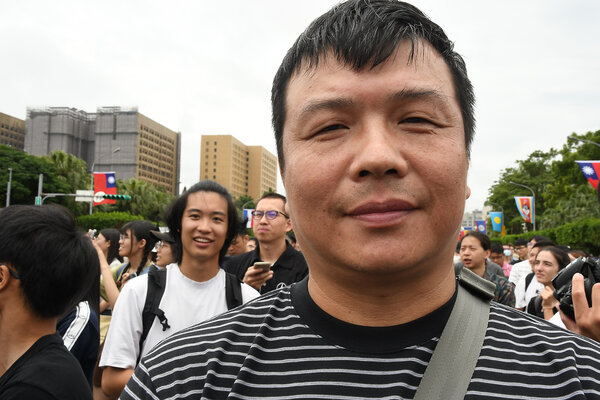
De-facto independent?
Dr. Lai said Taiwan’s government is ready to hold dialogues and boost cooperation with China – offering to start by resuming cross-strait tourism, and allowing Chinese students to enroll in universities in Taiwan. “I hope that China will face the reality of the Republic of China’s existence, respect the choices of the people in Taiwan, and in good faith, choose dialogue over confrontation,” Dr. Lai said.
But he also warned Taiwan’s 23 million citizens that in pursuing peace with China, they “must not harbor any delusions” about Beijing’s long-standing aim of uniting Taiwan with the mainland – by force, if necessary. “So long as China refuses to renounce the use of force against Taiwan, all of us in Taiwan ought to understand that even if we accept the entirety of China’s position and give up our sovereignty, China’s ambition to annex Taiwan will not simply disappear,” he said.
China’s Communist Party-run state has never ruled Taiwan, but has claimed the island as part of China’s territory since 1949, when Mao Zedong’s revolutionary Red Army defeated Gen. Chiang Kai-shek’s Nationalist forces in the Chinese civil war. General Chiang and his troops retreated to Taiwan, relocating the Republic of China’s government – led by the Nationalist Party, or Kuomintang (KMT) – to Taipei.
Beijing responded to Dr. Lai’s inauguration speech by reiterating its position on Taiwan. “The day will come when China is completely reunified,” Foreign Ministry spokesperson Wang Wenbin said at a press conference on Monday. “Taiwan independence,” he said, is a “dead end.”
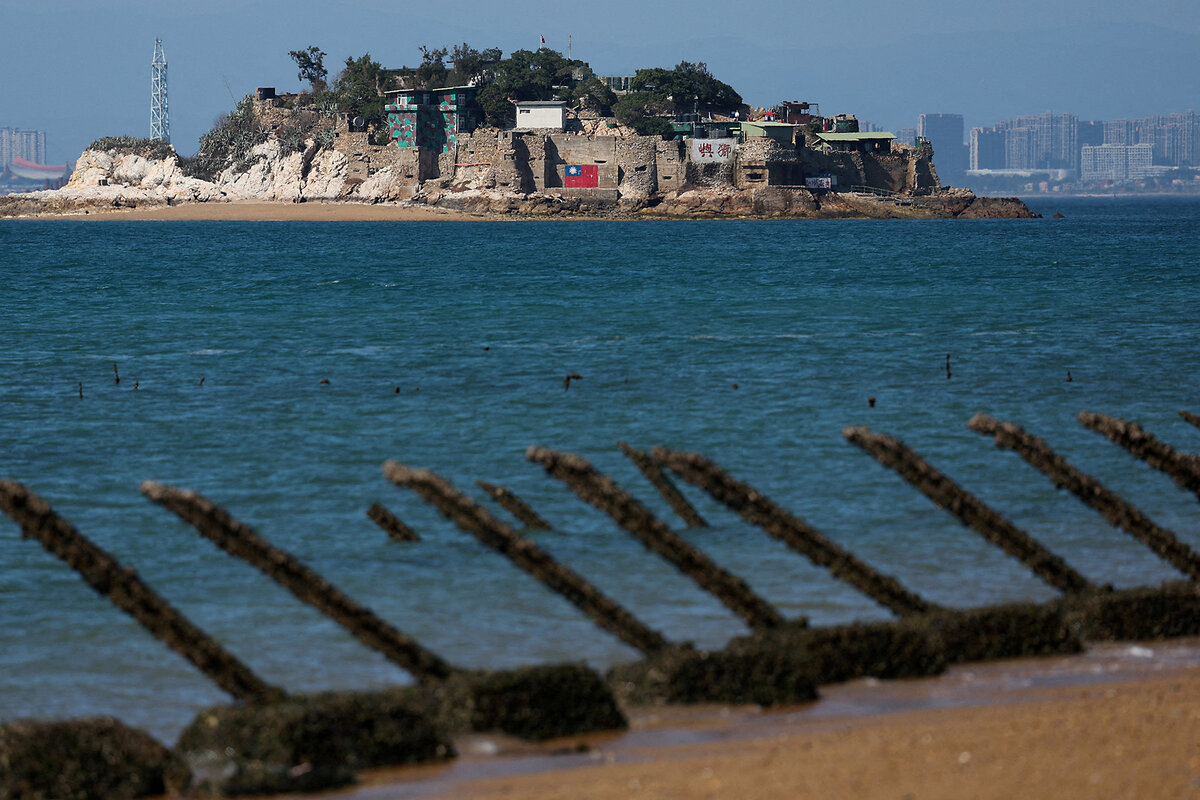
Beijing has condemned as “despicable” Dr. Lai, who once called himself “a practical worker for Taiwan independence.” Still, experts don’t expect any radical moves from Dr. Lai. The DPP position is that Taiwan is de-facto independent, so declaring independence is not necessary.
Dr. Lai “will most certainly avoid provoking China with moves toward Taiwanese independence,” says Lin Chong-Pin, an expert on cross-strait relations and a former Taiwan defense minister.
Meanwhile, China has recently shown signs of fine-tuning its approach to Taiwan, launching “a new charm offensive” aimed at Taiwanese people, while maintaining a hard line with the DPP, he says.
China’s response
China’s “strategy has shifted to a soft hand, which actively engages a broad cross-section of Taiwanese society … as distinct from the ruling party DPP,” Mr. Lin says. For example, China has begun inviting groups of Taiwanese students, veterans, college students, and neighborhood officials to the mainland, he says.
Beijing has also indicated that despite Dr. Lai’s victory, it sees an opportunity with the relatively strong January election showing by the opposition KMT, which historically backed Taiwan’s unification with mainland China. The DPP “cannot represent the mainstream public opinion on the island,” according to a January statement by the Taiwan Affairs Office of China’s State Council.
During the election, Beijing backed KMT candidate Hou Yu-ih. Although Mr. Hou came in second – with 33.5% of the vote compared with Dr. Lai’s 40% – the KMT gained the highest number of seats in Taiwan’s parliament, depriving the DPP of its legislative majority.
Since the election, the KMT has been actively working to undo DPP policies, and is in a position to block new initiatives by Dr. Lai, says Nathan Batto, Associate Research Fellow at the Institute of Political Science, Academia Sinica. “Lai will be able to run the government, but he will not be able to pursue an ambitious new agenda unless the KMT and/or TPP [Taiwan People’s Party] agree to it,” Dr. Batto says.
In April, Chinese leader Xi Jinping met with former Taiwan president Ma Ying-jeou, of the KMT, in Beijing. “Compatriots across the Strait have always been one family,” Mr. Xi told Mr. Ma, stressing the historical, cultural, and blood ties between Taiwan and mainland China. “No force … can separate us,” he said.
Beijing “has tried to signal that their approach to Taiwan is working … that peaceful reunification remains possible,” says Amanda Hsiao, Senior China Analyst for the International Crisis Group.
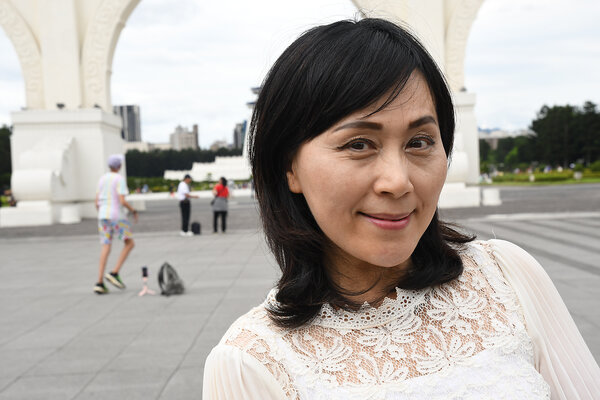
“China has been using a smaller and perhaps a sharper stick, and is dangling some carrots,” she says.
President Lai underscored on Monday that, in dealing with China, Taiwan would “neither yield nor provoke.” He stressed that Taiwan’s strength grows through its solidarity with other democracies, which together can combat disinformation and heighten deterrence.
Yi-ling Huang, a real estate agent who watched the inauguration on television, says Dr. Lai is striking the right balance. “He is not against the mainland but he wants us to be strong and not easily bullied,” she says. “He wants the world to see Taiwan, and what Taiwan can contribute to the world.”

How doulas and cafes help people break the last taboo – talking about death
The death of someone you love can feel like a very solitary – and silent – experience in America. Death educators are trying to create space for people to talk about everything from wills to questions about the afterlife and their own legacy.
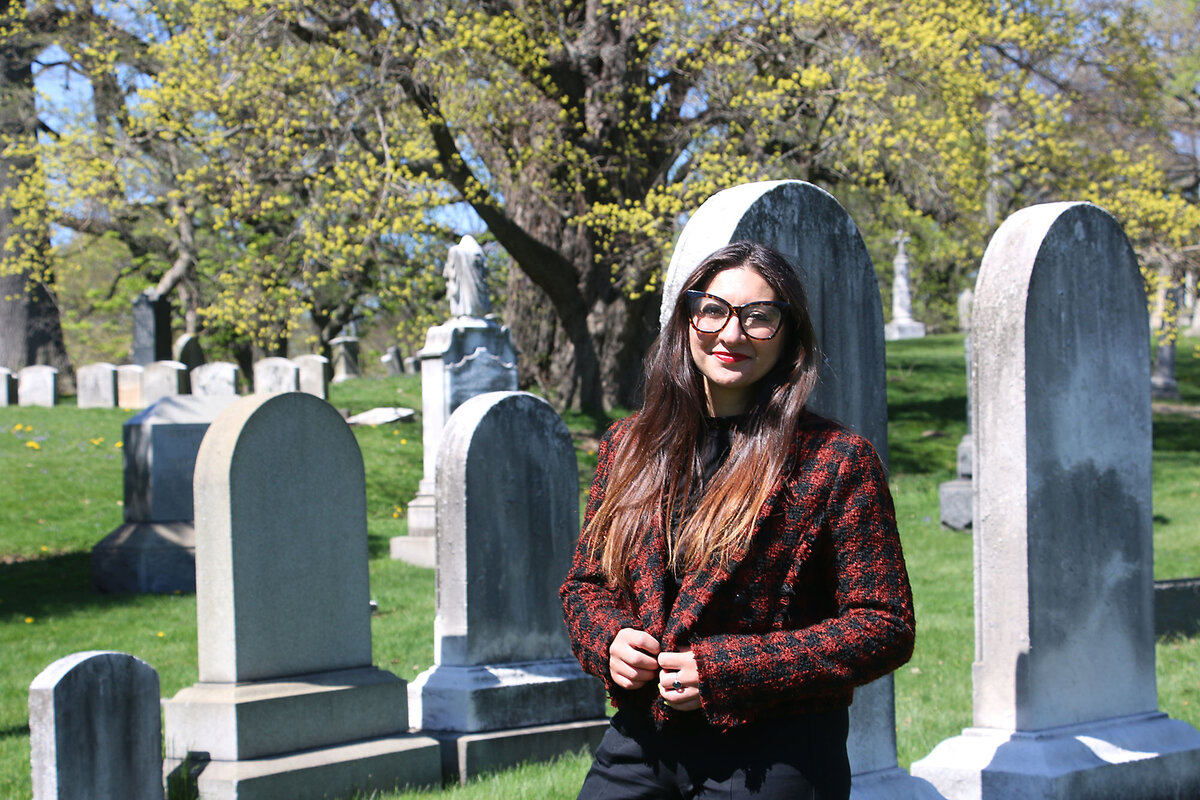
- Quick Read
- Deep Read ( 5 Min. )
In cafes and community centers, classrooms and studios and online, conversations are challenging people’s long-held senses of fear and shame about contemplating death. And a new kind of role, the death educator, is springing up to help facilitate that destigmatization.
It’s a new look for an old vocation, says Cole Imperi, an author and thanatologist, or death researcher.
“People who know about death, dying, grief, and loss have always existed and always been in our communities,” she says. Think clergy and bereavement committees, and among Indigenous groups, shamans or medicine women.
But in the United States, the trends of secularization and increased relocation have left a vacuum.
“If you came from a very conservative background or highly religious background, you might have been taught that you don’t talk about the dead,” she explains. “Many people are raised with different ideas about fear connected to death. People end up carrying this stuff with them throughout their whole lives.”
How doulas and cafes help people break the last taboo – talking about death
Where can you find a grandmother knitting a baby blanket next to a teenager crocheting a bikini top? “The cemetery” might not be the likeliest of answers.
Gabrielle Gatto certainly didn’t expect to encounter such a multigenerational scene the first time she arrived at Grieving & Weaving, a monthly meetup at Green-Wood Cemetery in New York City. But she says the event’s broad popularity speaks to universal interest in a topic that’s hard to find opportunities to talk about.
Both fiber artists probably had “very different motives” for attending, Ms. Gatto says. “But they’re both in that room because they want to talk about grief. They want to live and lead more thoughtful lives.”
Ms. Gatto is Green-Wood’s resident death educator. She coordinates programs that include financial end-of-life planning seminars and the Mortality & Me book club. Last month, participants gathered for a class on the art of the condolence letter.
These offerings have been known to fill to capacity, Ms. Gatto says. Death remains a taboo in the outside world, but despite that – or perhaps because of it – community members are eager to come and engage with the subject.
“I get to see what people are yearning for, and then create events and programs around it – and make it, dare I say, a little fun, right?” she says. “It’s creating these more positive outlets for processing these kinds of feelings with community.”
For much of human history, the issues of death and dying have been predominantly handled though religion and rites of organized faith. But as the United States became more secular, the loss of customs left a void. Increasingly, people are looking for new ways to talk openly about a difficult subject – and often to help process the emotions surrounding it.
The result has been a surge in people focused explicitly on improving access to people’s literacy and comfort with the topic. It’s a niche that Cole Imperi, an author and thanatologist, or death researcher, argues is sorely needed.
“If you came from a very conservative background or highly religious background, you might have been taught that you don’t talk about the dead,” she explains. “Many people are raised with different ideas about fear connected to death. People end up carrying this stuff with them throughout their whole lives.”
What does death education look like?
In cafes and community centers, classrooms and studios and online, conversations are challenging people’s long-held senses of fear and shame about contemplating death. The role of death educator is springing up to help facilitate that destigmatization.
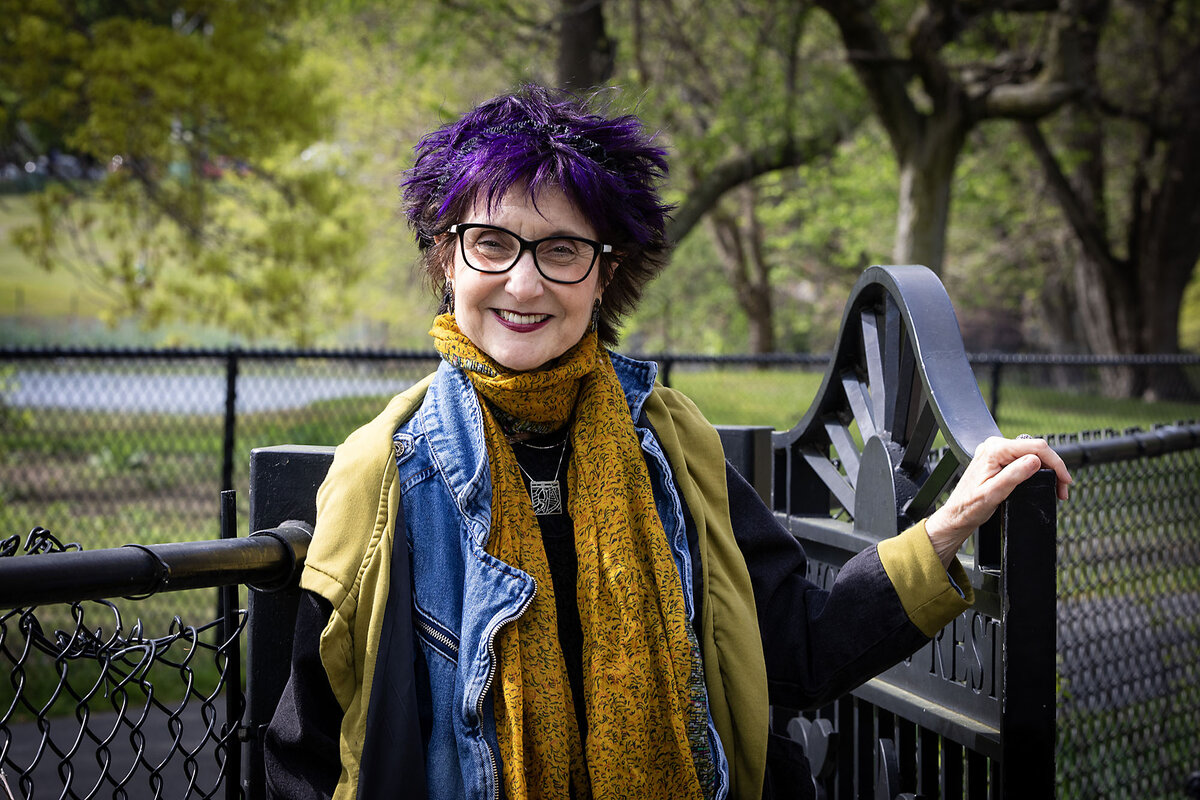
It’s a new look for an old vocation, says Ms. Imperi. “People who know about death, dying, grief, and loss have always existed and always been in our communities,” she says. Think clergy and bereavement committees, and among Indigenous groups, shamans or medicine women. “Typically, though, they’re not called death educators.”
The goal of today’s death education, says Anita Hannig, an anthropologist and author who studies death, is to find ways to address mortality without taking on the baggage that often accompanies it.
“We’re trying to create a safe container for us to have those conversations and not be labeled as morbid, suicidal, or weird and obsessed with death,” she says.
Some people’s first encounter might be a death cafe. Popularized in 2011 by Jon Underwood, these gatherings numbering in the thousands have taken place across 90 countries.
The rules of death cafes are simple: They are respectful and confidential. They shouldn’t have any particular agenda. They shouldn’t be held with the intention of leading participants to any particular conclusion. And they should, ideally, involve cake.
“We’re not selling anything. We’re not proselytizing for anything in the world. It’s not a grief session, but at heart, it’s a gathering of strangers who share the most fundamental commonality,” says Carol Lasky, a volunteer death cafe facilitator in Boston.
The unstructuredness of death cafes means participants can steer the conversation to larger topics, like questions of an afterlife, legacy, or a bucket list. But they can also find it helpful to dig into more functional topics, like funeral planning, wills, and burial methods. The ultimate goal, says Jay Davani, a facilitator in Providence, Rhode Island, is to build comfort so the practicalities of dying feel less daunting, and so they can be addressed before they become acute.
“You’re able to prepare yourself, your documents, your wishes,” she says.
Death education can also be a one-on-one experience. That’s exemplified by the death doula – a person who, like a birth doula, works to address the needs of a dying person and their loved ones, as a supplement to palliative or hospice care providers.
For Ms. Gatto, that work can start by helping people work through their questions and fears, or begin by creating plans for remembrance ceremonies.
When a client is dying, she finds doulas can add elements of humanity that might not otherwise factor into their care. For her aunt, who died recently, she tracked down chocolate ChapStick – helping address the loss of moisture in her lips, but also touching on her longtime love of chocolate pudding.
“I was able to come in and do those tiny little ritualesque things that felt very unique to her,” Ms. Gatto says. “I help curate conversations or scenarios like that for people. ... We’re here for you, and so compassionately. No judgment.”
Processing death via a community
But death education, proponents point out, is not just helpful for facing one’s own concerns. Young people who have less familiarity with bereavement can find it particularly meaningful to examine the phenomenon.
During the three semesters that Dr. Hannig offered an Anthropology of Death and Dying course at Brandeis University, at least one student each term would inevitably face a death in the family. She left it up to them whether to attend class.
Most of them said, “‘This is actually the most helpful thing for me, to come to class,’” she says. “‘Because here, I can actually process this huge thing that’s happened in my life. And in my other classes, I’m supposed to be OK, or it’s just not talked about.’”
That’s the core of the genre: finding ways to process one of life’s most challenging milestones, in community.
“For many of them,” Dr. Hannig says of her students, “it felt incredibly liberating.”

Essay
A potato masher, didgeridoo, and, uh, six vacuums. Why I rescue trash.
Rescuing, repairing, and reusing abandoned items is a lost art and a boon to the environment. And, as our essayist discovered, it can also spark unexpected adventures.

- Quick Read
- Deep Read ( 5 Min. )
-
By Owen Thomas Contributor
“Where did we get this?” my wife asks me when she comes across a new-to-her item in our household. She already knows the answer: Either I bought it at a yard sale, or I found it on the street.
Items in that category include: the desk chair I’m sitting in, a much better potato masher than the one I broke, a splitting maul, silverware I keep in the car so we don’t use plastic stuff when we eat at the fish place, a banjo, and a didgeridoo. And, uh, six vacuum cleaners.
It is difficult to shame me about this, though I may be vulnerable on the vacuum collection.
So what if my personal imperatives mean rummaging in a cardboard box on the sidewalk while my dog tugs on her leash? However, I do occasionally rehearse what I’d say if I were to encounter someone I know while I’m carrying, say, a rescued banjo. “Where’s your banjo?” perhaps, or “This is how Steve Martin got his start.”
If you’re grasping a splitting maul, a terse nod will suffice.
A potato masher, didgeridoo, and, uh, six vacuums. Why I rescue trash.
Earth-friendly living can sometimes be confused – confused, mind you – with cheapness. And while reducing and recycling can be accomplished out of the public eye, reusing may expose one to scrutiny.
“Where did we get this?” my wife asks me when she comes across a new-to-her item in our household. She already knows the answer: Either I bought it at a yard sale, or I found it on the street. Let’s say “rescued,” actually. Rescued it from the street.
Items in that category include: the desk chair I’m sitting in, a much better potato masher than the one I broke, a splitting maul with an intact handle (unlike mine), silverware I keep in the car so we don’t use plastic stuff when we eat at the fish place, a banjo, and a didgeridoo. And, uh, six vacuum cleaners.
It is difficult to shame me about this, though I may be vulnerable on the vacuum collection. I feel both a moral and a pecuniary impulse. Why should something go to a landfill if I have a use for it? Why should I pay top dollar for something if I can snag one that’s as good (or better) at low or no cost? Town tradition enables me: People just leave stuff out with “FREE” signs on it.
So what if my personal imperatives mean rummaging in a cardboard box on the sidewalk while my dog tugs on her leash and the occasional passing car toots a hello? However, I do occasionally rehearse what I’d say if I were to encounter someone I know – or someone I don’t know who looks alarmed – while I’m carrying, say, a rescued banjo. “Where’s your banjo?” perhaps, or “This is how Steve Martin got his start.” If you’re grasping a splitting maul, a terse nod will suffice.
I paid cash for an aircraft carrier once. It was a toy aircraft carrier, but a spectacular one. It was the most plastic I’d ever seen in one place: 5 feet long, 3 feet wide, and 2 1/2 feet tall. It was in pieces when I bought it from a friend, and woefully incomplete.
Our three boys were young then, and money was tight. I was experienced at this. Cocky, even. Using toll-free numbers (the internet was nascent), I felt I could restore the waterline model to its epic glory.
Sadly, I could not. I couldn’t find parts. I did acquire instructions, which solved some mysteries while revealing how many more pieces were not included.
Just as well. It was gigantic. It fit in the living room, but just barely. This meant it was out and assembled (sort of) for only short periods of time. The boys quickly outgrew it, and I moved it along. It felt right to sell it for what I’d paid: four bucks.
Telling Stories Readers Can’t Resist
What does it take to weave a creative nonfiction tale that’s engaging and universal enough to draw readers all the way through? Owen Thomas, a longtime editor of essays for The Home Forum at the Monitor – and now a contributing essayist himself – joins host Clay Collins to talk about that question, and about how his work aligns with the Monitor’s mission to find and celebrate the humanity behind every story we tell.
My internet-fueled confidence in locating and installing replacement parts, my cleaning skills (many nondish items do fit in a dishwasher), and my eagerness to restore value inexpensively might explain the vacuum cleaners. Some objects call out to me for redemption, and often I must lug them home. You will be relieved to know that at present we own but one vacuum. The others – cleaned or repaired or both – have all found loving homes. I even helped a gentleman select from among my display (free) at the end of our drive. Do I miss them? Sometimes ...
In case you’re persuaded that you, too, should peer into cardboard boxes along your route, or visit the yard sale next door, I offer this cautionary tale.
I spotted the rug immediately at a yard sale that was winding down. It looked new, and I didn’t have to talk myself into admiring the pattern. It had a medium nap and was a good size – 5 by 8 or better. Twenty bucks. I couldn’t get the money out of my wallet fast enough.
Not until I got it home and inside did I realize why the rug had been so inexpensive and yet still available. What was that smell?
It was not a wanton-pet smell, but a penetrating, chemical odor. Would it yield to cleaning? It would not.
I went online, and found that this carpet was notorious. The glue used to attach the fibers to the backing was off-gassing VOCs (volatile organic compounds) and would do so far into the indeterminate future.
Out to the curb it went. I like to think it may have become the Flying Dutchman of floor coverings, sailing from curbside to home and then rapidly back to a new curb. It may be out there still.
Reusing is noble and economical. It can enrich one’s experience – how else would I know how hard it is to play a didgeridoo? Reusing requires daring, even brazenness. One must be impervious to sidelong glances. It rewards with the satisfaction of having spotted and redeemed unseen value and worth.
But if you decide to join me in this campaign, remember: Wake up and smell the carpet.
Other headline stories we’re watching
(Get live updates throughout the day.)The Monitor's View
War in Gaza sparks a reckoning
- Quick Read
- Deep Read ( 3 Min. )
-
By the Monitor's Editorial Board
A breakdown in talks on a cease-fire in Gaza and a rift in Israel’s war Cabinet underscore a big question: how to end the war. Yet in a different direction, the contours of a lasting peace between Israelis and Palestinians are increasingly visible. “There’s a view of a future for Israeli and Palestinian people that rejects the notion that the conflict is inevitable,” noted Allen Weiner, a senior lecturer at Stanford Law School.
Discontentment runs high in both societies over failed leadership. Israelis have gathered in mass protests against the current government. A poll shows only 35% of Jewish Israelis are optimistic about the future of democratic rule and security in their country. A similar shift is unfolding among Palestinians. The latest poll found that support for Hamas among Palestinians in Gaza had fallen to 34% from 42% three months ago.
Beyond those parallel shifts, the greater movement of attitudes driven by the war is toward unity. Hundreds of Israeli, Palestinian, and joint civil society organizations are promoting models of peace based on coexistence and shared security.
“You have to really let go of the past and forgive,” said Hamze Awawde, a Palestinian peace builder.
War in Gaza sparks a reckoning

A breakdown in talks on a cease-fire in Gaza and a rift that opened over the weekend in Israel’s war Cabinet underscore a big question: how to end the war. Yet in a different direction, the contours of a lasting peace between Israelis and Palestinians are increasingly visible more than seven months after the Oct. 7 attack by Hamas.
“There’s a view of a future for Israeli and Palestinian people that rejects the notion that the conflict is inevitable,” noted Allen Weiner, a senior lecturer at Stanford Law School. The basis of that view is a shared rejection of extremism and a deepening conviction in both societies that an antidote resides in democratic values.
“Our loss and our pain have made us brothers,” said Aziz Abu Sarah, a Palestinian entrepreneur and advocate for peace. Mr. Abu Sarah and an Israeli counterpart, Maoz Inon, addressed a peace rally in Italy on Saturday.
“We cry together, and we dream together,” he told a crowd of 13,000, with Mr. Inon at his side. “We dream that the walls of ignorance, fear, and hate that divide us will fall down. Both of us lost loved ones ... but we have not lost our humanity. Our pain has led us to envision a shared future together.”
Discontentment runs high in both societies over failed leadership. Israelis gathered in protests against the current government on Saturday and again on Monday at the start of a new session of the Knesset, Israel’s parliament. A poll by The Israel Democracy Institute showed last week that only 35% of Jewish Israelis and 18% of Arab Israelis are optimistic about the future of democratic rule and security in their country.
“The battlefield is not only in Gaza,” said Eitan Turgeman, an Israeli military reservist and founder of a peace organization called Tikun 2024 (tikun means “repair” in Hebrew). Ideologically conservative, Mr. Turgeman used to argue combatively on social media about politics. “I’m not doing that anymore,” he told The New York Times. “I’m challenging the way I think.”
A similar shift is unfolding among Palestinians. The latest poll by the Palestinian Center for Policy and Survey Research in March found that support for Hamas among Palestinians in Gaza had fallen to 34% from 42% three months ago.
Beyond those parallel shifts, the greater movement of attitudes driven by the war is toward unity. Hundreds of Israeli, Palestinian, and joint civil society organizations promote models of peace based on coexistence and shared security. Tikun 2024 is just one of several started by Israeli military reservists. An Israeli podcast called “Unapologetic” strives to defuse extremism by creating “a space for compassion for acceptance and nuanced conversations” beyond hatred.
“We have two people that are inextricable,” said Masua Sagiv, a visiting professor at the University of California, Berkeley School of Law. She describes herself as Israeli, Jewish, Zionist, and pro-Palestinian. “No one is going anywhere. Neither Palestinians, neither Israel. If no one is going anywhere, that means that both people are responsible for the safety of the other.”
Hamze Awawde, a Palestinian peace builder, added, “You have to really let go of the past and forgive.”

A Christian Science Perspective
Each weekday, the Monitor includes one clearly labeled religious article offering spiritual insight on contemporary issues, including the news. The publication – in its various forms – is produced for anyone who cares about the progress of the human endeavor around the world and seeks news reported with compassion, intelligence, and an essentially constructive lens. For many, that caring has religious roots. For many, it does not. The Monitor has always embraced both audiences. The Monitor is owned by a church – The First Church of Christ, Scientist, in Boston – whose founder was concerned with both the state of the world and the quality of available news.
Waking up to wrongdoing
- Quick Read
- Read or Listen ( 3 Min. )
-
By Liz Butterfield Wallingford
We’re all capable of knowing ourselves (and others) as God made us – full of integrity, goodness, and love – and letting that view drive how we live our lives.
Waking up to wrongdoing
A guy asks his dad for his inheritance right then. His dad gives it to him, and the son heads off to a distant land, where he squanders it all. Then a famine arises, so he has neither food nor money. He gets a job feeding pigs, and things are so desperate that he yearns to eat what the pigs are eating.
At this point, it hits him: It doesn’t have to be this way! He decides to travel back home, admit to his bad decisions and behavior, renounce his status as son, and ask his dad to take him on as a servant.
This is the first half of a parable that Christ Jesus told (see Luke 15:11-32). Haven’t we all been there, to some extent? Even if we haven’t hit rock bottom, perhaps we’ve behaved in a way that doesn’t reflect our best self, losing sight of what’s good and true about one’s identity.
How do we get to that moment of humble realization that (a) we’ve gone down the wrong path and (b) there is, in fact, a way forward and out?
My favorite line in the story comes at the moment when this guy has that very realization. The Bible says that “he came to himself.”
This suggests that this guy always had it in him to express wisdom, humility, and integrity. The self-centeredness, recklessness, and capriciousness were a disguise of sorts – not part of his genuine self. I like to think of “coming to himself” as gaining some degree of awareness of his better nature – his true nature.
Christian Science, which is based on the Bible – including Jesus’ teachings – expands on the idea of our true nature. It explains that we’re so much more than the fallible mortals we seem to be. We’re God’s children, the reflection of the divine Spirit – and therefore not mortals at all, but entirely spiritual and good, reflecting God’s own nature.
This means that our true identity is characterized by unselfishness, compassion, joy, and more. That’s how God made us. So we’re all divinely equipped to let those kinds of qualities take the lead in our lives.
This doesn’t absolve us of bad behavior. On the contrary, it offers a strong foundation for waking up to wrongdoing – thoughts and actions that aren’t consistent with our true identity as God’s loving, intelligent, principled spiritual offspring – and then making amends and doing better moving forward. The textbook of Christian Science, “Science and Health with Key to the Scriptures” by Mary Baker Eddy, assures, “Know thyself, and God will supply the wisdom and the occasion for a victory over evil” (p. 571).
I experienced this in a modest but encouraging way when I was growing up. There was a period when I would steal things – a sticker from a friend’s desk, an eraser from the elementary school store, a dollar from my dad’s wallet, that kind of thing. I knew it was wrong but would do it anyway.
Then one day in my Christian Science Sunday School class, we played a game where the teacher would hold up an index card with a quality written on it, and we students would decide whether it described the nature of God’s children. If it did, we’d lay it on the table; if not, we’d drop it on the floor.
The table became covered with adjectives like “truthful,” “fair,” and “kind,” and the vibe on the floor was more like “dishonest,” “selfish,” and “unprincipled.” I felt so drawn to the table qualities, to the extent that the floor cards struck me as describing a shadow of an individual, not anyone’s actual self. They just didn’t seem legitimate or substantive.
From that morning on, I never again felt that impulse to steal. And I found ways to recompense – with interest – those I had taken from, and was met with forgiveness.
On a greater scale, the guy in Jesus’ parable finds forgiveness, too. His dad celebrates with joy the return of his son, who “was lost, and is found.”
If we go astray, losing sight of what we truly are as God’s spiritual offspring, we’re not doomed to remain there. God’s redeeming, reforming Christ message is active at every moment, helping us to know our true selves and to let our innate goodness shine through in our lives.

Viewfinder
Blue blurs, Red Square
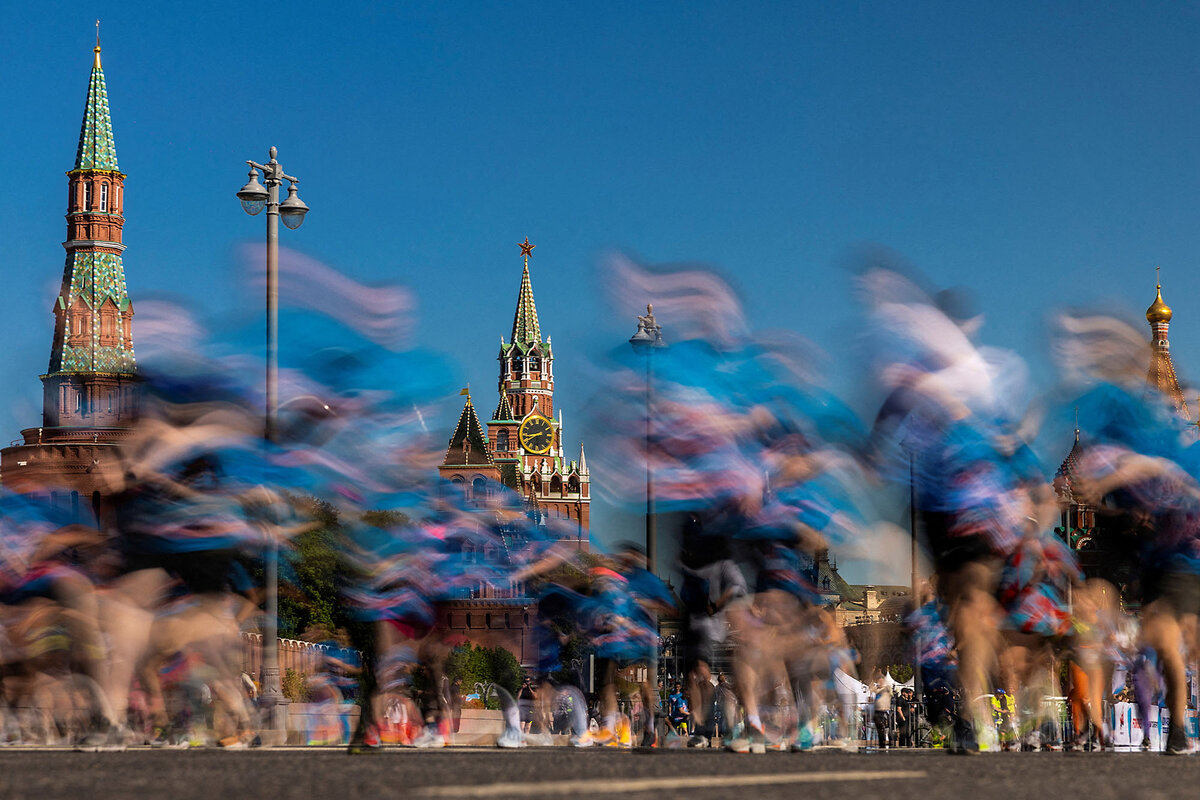
A look ahead
Thanks for starting a new week with us. Tomorrow, Laurent Belsie will explore the question of whether Google’s dominance in the realm of internet search might evaporate. At the very least, artificial intelligence is likely to disrupt the status quo.



